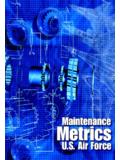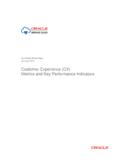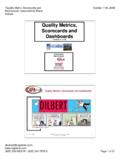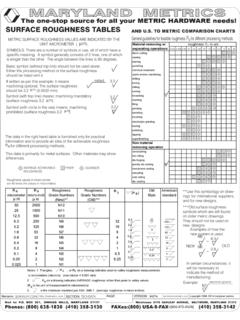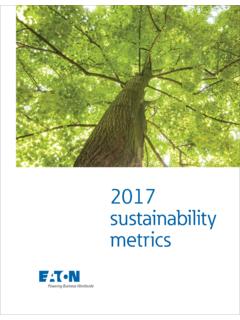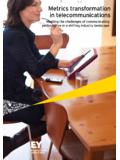Transcription of Measuring the Street - Welcome to NYC.gov
1 Measuring the Street : New metrics for 21st Century Streets 1. Measuring the Street : New metrics for 21st Century Streets New york city 's streets are constantly called on to the meet new and varied needs of a growing, dynamic, 21st Century city and to do this in a complex environment where there is little opportunity to expand the existing footprint. How do city leaders address these challenges and measure their success? This report discusses key approaches to Street design projects, and how results can be measured against goals for safety, serving all users and creating great public spaces while also maintaining the flow of traffic.
2 Using a cross-section of recent NYCDOT. Street design projects, this report details the metrics NYCDOT uses to evaluate Street projects, and illustrates how Measuring results can show progress toward safe, sustainable, livable and economically competitive streets. Goals Strategies Designing safer streets, to provide safe Design for and attractive options for all Street users .. safety Building great public spaces to create economic value and neighborhood vitality .. Design for all Improving bus service to bring rapid users of the transit beyond the subway .. Street Reducing delay and speeding to allow for Design faster, safer great public Efficiency in parking and loading spaces to improve access to businesses and.
3 Neighborhoods 2. Cities need to set new goals for their streets if they are to meet the needs of a dynamic and growing city and address the problems of vehicle crashes, traffic congestion, poor-performing bus and bike networks, and environments that are inhospitable for pedestrians. New york has been able to transform our streets by blending new technologies with time-tested tools to create 21st Century Streets for all users. The projects described in this report demonstrate this approach. The metrics shown here track the success of these projects, inform the design of future projects and are vital to building public support for world-class streets.
4 metrics Crashes and injuries for motorists, ..Page 4 pedestrians, and cyclists Volume of vehicles, bus passengers, bicycle ..Page 6 riders, and users of public space Traffic speed, aiming to move traffic not too ..Page 8 slowly, but also not too fast Economic vitality, including growth in ..Page 10 retail activity User satisfaction ..Page 12. Environmental and public health benefits 3. Designing safer streets Safe and attractive options for all users First protected bicycle lane in the US: 8th and 9th Avenues (Manhattan). Left turn bays 35% decrease in and signal injuries to all Street phases users (8th Ave). 58% decrease in injuries to all Street users (9th Ave) Mixing zones for bicycles and left- Up to 49% turning vehicles increase in retail sales (Locally-based businesses on 9th Ave from 23rd to 31st Sts.)
5 , compared to 3% borough-wide). Parking-protected Pedestrian safety bike lane islands 4. The city 's streets are unique because of the mix of people using the same space. Planning for safety, Key metrics which is at the heart of every DOT initiative, means Crashes and injuries to helping pedestrians, motorists, bus riders, and cyclists coexist safely. Here our focus has been on organizing motorists and other vehicle the different streams of traffic by simplifying occupants, pedestrians, intersections; by creating dedicated lanes for turning cyclists, and motorcyclists drivers and for cyclists; and by setting aside signal time and safe space for crossing pedestrians.
6 Vehicle speeds Neighborhood traffic calming: East 180th Street (Bronx). 67% decrease in pedestrian crashes 29% decrease in eastbound speeding 32% decrease Painted in westbound median speeding Dedicated Widened left turn parking bays lanes 5. Building great public spaces Economic value and neighborhood vitality Expanding an iconic space: Union Square North (Manhattan). Speeding decreased by 16%, while median speeds increased by 14%. Injury crashes fell by 26%. 49% fewer commercial vacancies (compared to 5% more borough-wide) Protected bicycle path 74% of users prefer the new configuration Pedestrian plaza Simplified intersections 6.
7 New york 's streets serve more functions than Key metrics simply moving people and goods. In such a densely Economic vitality (sales populated city , the streets and sidewalks are places to congregate, relax, and enjoy being out in public. tax receipts, commercial We have focused on creating great public spaces that vacancies, number of visitors). serve individuals and groups large and small. Local organizations who maintain and program our public User satisfaction, revealed spaces help us ensure that these spaces will remain through surveys functional and useful for all users. Number of users Transforming an underused parking area: Pearl Street (Brooklyn).
8 172% increase Maintenance partner agreement in retail sales (at locally-based businesses, compared to 18%. borough-wide). BID held 27 public events in 2012. Pedestrian plaza Creating a seating area out of curb lane: Pearl Street (Manhattan). 77% increase in Striping and seated pedestrians planters 14% increase in sales at fronting businesses Seasonal seating platform in curbside lane 7. Improving bus service Rapid transit beyond the subway Making bus routes work better: Fordham Road (Bronx). 20% increase in bus speeds Transit signal priority 10% increase in bus ridership 71% increase in retail sales (at locally-based businesses, compared to 23% borough-wide).
9 Delivery windows (curb dedicated to trucks at key times). Curbside red bus lanes 8. Even though most New Yorkers use mass transit every day, the city 's buses are the slowest in North America. Key metrics In partnership with MTA New york city Transit, DOT. has introduced a new level of bus service, Select Bus Bus ridership Service (SBS), to some of the city 's busiest corridors. SBS includes off-board fare payment, three-door Bus travel speeds boarding to reduce boarding time; red bus lanes and Transit Signal Priority (TSP) to keep buses moving; Economic vitality (sales and new shelters , buses, and bus bulbs to improve tax receipts, commercial the passenger experience.)
10 SBS projects also include vacancies, number of features to enhance pedestrian, cyclist, and traffic visitors). flow and safety. Dedicated lanes for both buses and bikes: First and Second Avenues (Manhattan). 18% increase in bus speeds 12% increase in bus ridership Up to 177% Separated left turn lanes and dedicated increase in bicycle signal phases volumes 47% fewer commercial vacancies (compared to 2% more Offset red borough-wide) bus lanes 37% decrease in injury crashes Protected green bike lanes Pedestrian 9. 9. refuges Reducing delay and speeding Faster, safer travel Creative traffic engineering for wide streets: Hoyt Avenue at the RFK Bridge (Queens).










